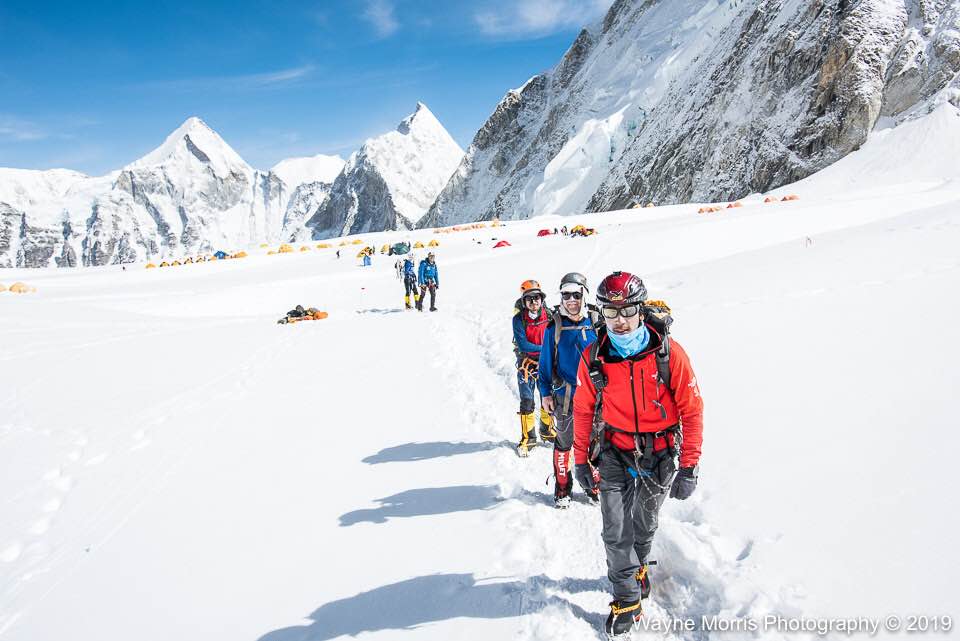Hello everyone,
Sometimes a short update from the hill is the best kind of update. When there’s not too much to report, it means all is going smoothly, easily and well, which indeed it is.
Our first & second wave of climbers (so the IFMGA Team, Personal Sherpa climbers and Privates) are back to Base Camp and no doubt plugging into the excruciatingly slow Everest wifi (bear with them if their audio calls drop or Facetime calls are a thing of fantasy) and rolling into the Big House to chill out, after well deserved steaming hot showers and a feast.
Meanwhile, our final wave (being our Western Guided, Private Group Kent and Fred and Lhotse climber Robert) have headed up to Camp 1 to begin their first rotation. They’ll follow a similar schedule with a sleep at Camp 1, an acclimatization hike up the CWM to Camp 2 (tomorrow) returning for a second night sleep at Camp 1 before moving up to Camp 2 to sleep the following day and then dropping back down to EBC.
As I’m sure many of you know, the purpose of all the ‘up and down’ ‘up and down’ climbing rotations is to give the body a chance to acclimatize and this is a fascinating process. I’m about to go all biology geek on you so beware (but also a quick disclaimer, I’m not a physician so if this process is a little generalised, forgive me) …
The higher our climbers go the less dense the atmosphere, simply meaning the oxygen molecules in the air are further apart which is why we say ‘thin air’. At sea level, the atmospheric pressure is about 1.04kg per square cm. That’s a nice heavy level of pressure that helps give the oxygen an extra push to pass through the selectively permeable lung membranes and into the blood. However, the higher you go, the lower that pressure becomes and therefore the less likely it is that the oxygen molecules actually pierce through the lung membranes and get themselves into the haemoglobin of the red blood cells where they get transported to the rest of the body.
Think of atmospheric pressure as a giant ‘press’ pushing down on the oxygen molecule and ‘stamping’ it into its seat inside the red blood cell. At higher altitude, that extra assistance isn’t there. On top of that, the oxygen molecules are also further apart so you are less likely to come across as many of them in each breath as you would at sea level. So how does the body make up for it?
At first, there are superficial changes, the body increases breathing rate (to increase the chance of taking in the same level of oxygen but from much sparser air) and your heart rate and blood pressure also increase dramatically (even at rest) to help move more blood (hopefully oxygenated) around your system. The theory is the more you breathe & the more blood your heart pumps, the more chance an oxygen molecule gets to where it’s got to go. Following?
BUT (and here’s where it gets very cool) over time your body realizes it needs to make some more significant adaptations if it’s going to live up here successfully on Mt. Everest so it makes some longer-term adaptations to its efficiency. It increases the number of red blood cells as well as increases your capillaries and even your lung capacity and size. All of this change is to ‘up’ the probability of coming in contact with those precious (but flighty) little oxygen molecules. Understandably, these longer-term changes take time, (it’s tough work for the body) hence why Everest is a patience game. By doing rotations and increasing their high point a little more each time, the climbers put manageable stress on their bodies, bringing them up to a new threshold and then by taking time to rest, they give their bodies a chance to play catch up and adapt to this new normal.
When they get seriously high, they’ll go on oxygen which puts more oxygen molecules into their lungs on each breath, (but it still can’t increase the atmospheric pressure of it getting stamped through and into the red blood cells) so climbing Everest is a remarkable feat indeed, not just from a mental strength perspective but also from a physiological one. To put it in perspective, if I were to take you off your chair right now and whisk you away from to the summit of Everest you would pass out within a few minutes and die shortly after. The best example I can think of for how it might feel for our climbers is going to the gym and doing a high-intensity cardio workout whilst breathing through a straw. Tough right?
So while they kick back in the ‘Big House’ and watch movies and eat Kumar’s sensational food, be assured this is very much a vital part of their climb and their bodies are hard at work priming for the goal ahead.
To snap us out of our impromptu science lesson, here are some sensational pics from climber and talented photographer Wayne Morris – thanks Wayne!
Cheers
Caroline






